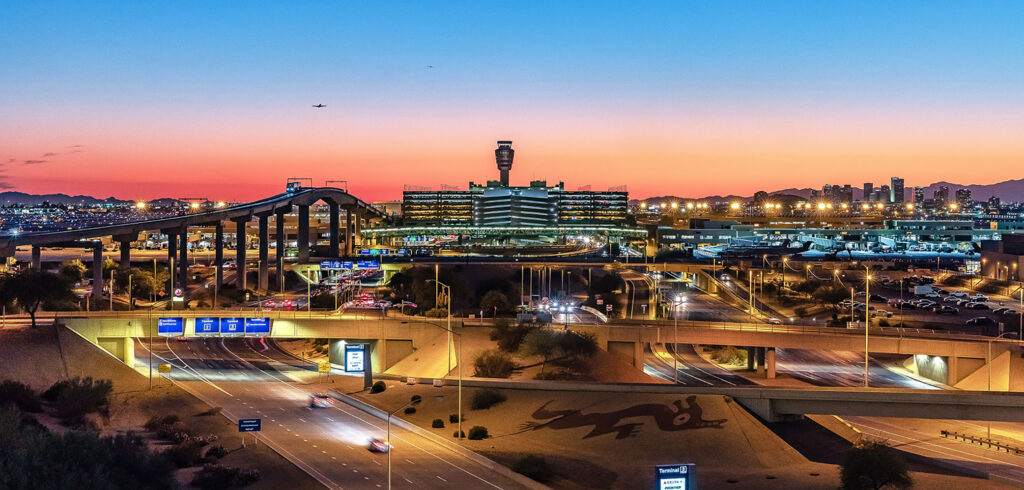Phoenix Sky Harbor International Airport in Arizona has received the Level 4 ‘Transformation’ Airport Carbon Accreditation (ACA) rating from Airports Council International – North America (ACI-NA) for the reporting year of 2021.
To meet the Level 4 requirements, Phoenix Sky Harbor set itself the goal of achieving net zero carbon by 2040 for emissions. In alignment with the City of Phoenix’s Climate Action Plan (CAP), Phoenix Sky Harbor identified the following CAP targets to serve as interim milestones to achieve the long-term net zero carbon goal: reduce carbon emissions from city operations by 40% by 2025 compared to 2005; achieve carbon-free electricity by 2030; and increase the efficiency of buildings by 30% by 2030 compared to 2012.
Since 2010, Phoenix Sky Harbor has reduced annual carbon emissions by 34% through energy conservation measures and on-site renewable energy, despite growth and expansion. Some examples include reducing water usage by more than 195 million liters a year, even with an increase in passengers served; reducing electricity usage by 17% and greenhouse gas emissions by 25%; and focusing on solar power by adding panels at the Rental Car Center and East Economy Parking areas and most recently at the Aviation HQ building. Additionally, the airport has increased its recycling rates by more than 40% and has implemented waste reduction strategies such as recycling asphalt and concrete into new pavements.
Alongside this recognition, the airport also published a report, A Roadmap to Net Zero Carbon, on its plan to reach net zero carbon emissions by 2040. To achieve net zero carbon, Phoenix Sky Harbor Airport seeks to reduce roughly 69,000 metric tons of carbon emissions, or as much as is feasible, before pursuing carbon removal technologies to account for residual emissions. According to the airport, the roadmap identifies the short-, medium- and long-term strategies for Phoenix Sky Harbor to reach this goal and satisfies the ACA requirement for identifying the specific carbon emissions reduction trajectory.
Phoenix Sky Harbor was additionally recognized for its commitment to reducing its environmental impact via ACI-NA’s separate Environmental Achievement Award. The airport was acknowledged in the Innovation Category for its Eighth Concourse in Terminal 4. The Eighth Concourse was developed with a focus on reducing environmental impact from the early planning stages throughout the design and construction lifecycle. From a ceiling comprised of recycled plastic bottles to walls incorporating sustainable paper atop recycled concrete, the Eighth Concourse exudes innovative and bold sustainable solutions. The concourse includes 4,267m2 of ‘smart’ windows that instantaneously tint to improve the built environment and enhance customer experience while reducing peak energy loads by as much as 20%. It also features a cooling system that recycles and saves water, charging stations for electric ground service vehicles and thousands of LED lights and water-efficient fixtures.
Kate Gallego, mayor of Phoenix, said, “A powerful economic engine and one of the busiest airports in the nation, Phoenix Sky Harbor is proving that integrating sustainability can be cost-effective and improve the customer experience. Through innovative heat mitigation, water conservation and decarbonization solutions, Phoenix Sky Harbor sets an example for airports across our country and around the world and gets us closer to our vision to make Phoenix the most sustainable desert city in the world.”
Laura Pastor, vice mayor of Phoenix, added, “This accreditation is one more example of how Phoenix is future-focused and future-friendly. This recognition is significant, but not surprising. I am proud to serve on a council that directs and supports staff in seeking opportunities to boost sustainability initiatives at Sky Harbor.”
Chad Makovsky, City of Phoenix director of aviation services, said, “We are committed to focusing on being future friendly. Our commitment requires an all-hands-on-deck approach – from airport staff and business partners to our valued passengers and the surrounding community. We are already working together to reduce our impact on the environment and have made great strides, but I look forward to continued collaboration and innovation.”

